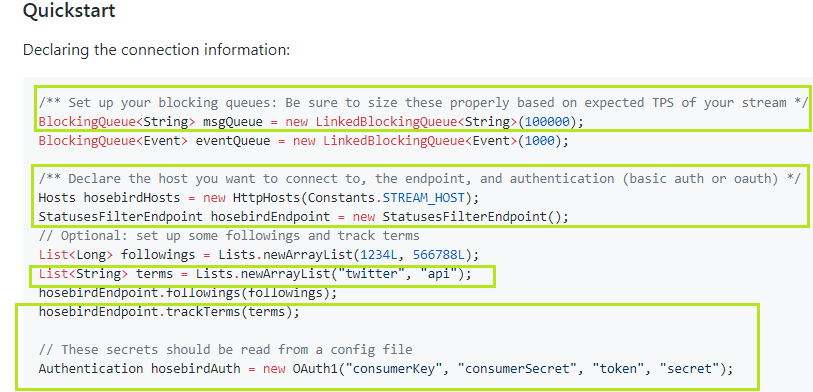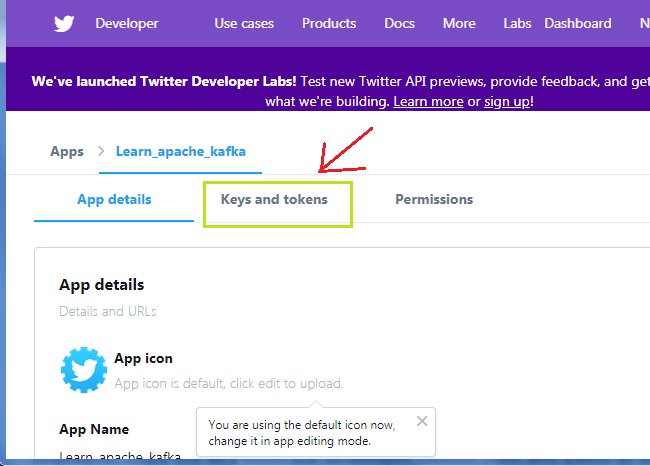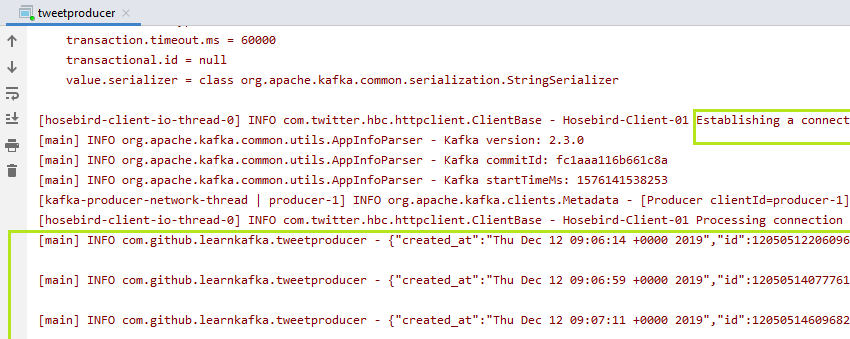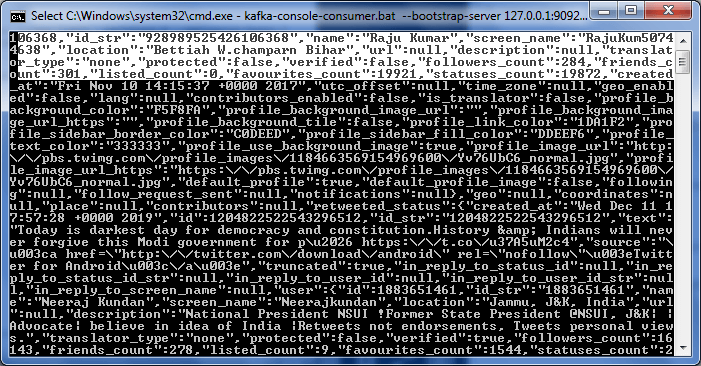在本节中,我们将学习创建Twitter生产者。
创建Twitter生产者基本上需要三个步骤:
- 创建一个Twitter客户端。
- 创建生产者
- 发送推文
步骤1:按照包命名约定规则创建一个新的Java包。然后,在其中创建一个Java类,说“ tweetproducer.java”。
步骤2:通过为其创建一个twitter客户端来创建一个方法。现在,将Quickstart代码从“ github twitter java”复制到twitter客户端方法,如下所示:

将其粘贴到新创建的方法中。此代码将在客户端和hbc主机之间创建连接。当队列为空或已满时,BlockingQueue将停止客户端使消息出队或入队。当我们使用hbc-core时,我们只需要msgQueue。此外,我们将遵守条款,而不是人民。因此,仅复制突出显示的代码。
现在,将连接代码下方给出的“创建客户端”代码复制为:

将代码粘贴到连接代码下方。此代码将通过客户端构建器创建一个twitter客户端。当我们使用msgQueue时,请勿复制红色的高亮代码,该代码用于eventMessageQueue。不需要。
第3步:使用引导服务器连接,以与上一节所述类似的方式创建生产者。
第4步:创建了Kafka生产者之后,就该将推文发送给Kafka了。从“创建客户端”代码下面给出的“ github twitter java”中复制while循环代码。粘贴在生产者代码下方。

现在,我们准备阅读Twitter上的推文。虽然,卡夫卡的制片人从一个主题中读取消息。因此,请在CLI上使用“ -create”命令创建指定的主题。另外,指定分区值和复制因子。
例如,

在这里,创建的主题“ twitter_topic”具有分区值6和复制因子1。最后,执行代码并在实际应用程序中体验Kafka。
创建Twitter客户端的完整代码如下:
package com.github.learnkafka;
import com.google.common.collect.Lists;
import com.twitter.hbc.ClientBuilder;
import com.twitter.hbc.core.Client;
import com.twitter.hbc.core.Constants;
import com.twitter.hbc.core.Hosts;
import com.twitter.hbc.core.HttpHosts;
import com.twitter.hbc.core.endpoint.StatusesFilterEndpoint;
import com.twitter.hbc.core.processor.StringDelimitedProcessor;
import com.twitter.hbc.httpclient.auth.Authentication;
import com.twitter.hbc.httpclient.auth.OAuth1;
import org.apache.kafka.clients.producer.*;
import org.apache.kafka.common.serialization.StringSerializer;
import org.slf4j.Logger;
import org.slf4j.LoggerFactory;
import java.util.List;
import java.util.Properties;
import java.util.concurrent.BlockingQueue;
import java.util.concurrent.LinkedBlockingQueue;
import java.util.concurrent.TimeUnit;
public class tweetproducer {
Logger logger = LoggerFactory.getLogger(tweetproducer.class.getName());
String consumerKey = "";//specify the consumer key from the twitter app
String consumerSecret = "";//specify the consumerSecret key from the twitter app
String token = "";//specify the token key from the twitter app
String secret = "";//specify the secret key from the twitter app
public tweetproducer() {}//constructor to invoke the producer function
public static void main(String[] args) {
new tweetproducer().run();
}
public void run() {
logger.info("Setup");
BlockingQueue<String> msgQueue = new
LinkedBlockingQueue<String>(1000);//Specify the size accordingly.
Client client = tweetclient(msgQueue);
client.connect(); //invokes the connection function
KafkaProducer<String, String> producer=createKafkaProducer();
// on a different thread, or multiple different threads....
while (!client.isDone()) {
String msg = null;
try {
msg = msgQueue.poll(5, TimeUnit.SECONDS);//specify the time
} catch (InterruptedException e) {
e.printStackTrace();
client.stop();
}
if (msg != null) {
logger.info(msg);
producer.send(new ProducerRecord<>("twitter_topic", null, msg), new Callback() {
@Override
public void onCompletion(RecordMetadata recordMetadata, Exception e) {
if(e!=null){
logger.error("Something went wrong", e);
}
}
});
}
}//Specify the topic name, key value, msg
logger.info("This is the end");//When the reading is complete, inform logger
}
public Client tweetclient(BlockingQueue<String> msgQueue) {
Hosts hosebirdHosts = new HttpHosts(Constants.STREAM_HOST);
StatusesFilterEndpoint hosebirdEndpoint = new StatusesFilterEndpoint();
List<String> terms = Lists.newArrayList("India ");//describe
//anything for which we want to read the tweets.
hosebirdEndpoint.trackTerms(terms);
Authentication hosebirdAuth = new OAuth1(consumerKey, consumerSecret, token, secret);
ClientBuilder builder = new ClientBuilder()
.name("Hosebird-Client-01") // optional: mainly for the logs
.hosts(hosebirdHosts)
.authentication(hosebirdAuth)
.endpoint(hosebirdEndpoint)
.processor(new StringDelimitedProcessor(msgQueue));
Client hosebirdClient = builder.build();
return hosebirdClient; // Attempts to establish a connection.
}
public KafkaProducer<String, String> createKafkaProducer(){
//creating kafka producer
//creating producer properties
String bootstrapServers="127.0.0.1:9092";
Properties properties= new Properties();
properties.setProperty(ProducerConfig.BOOTSTRAP_SERVERS_CONFIG, bootstrapServers);
properties.setProperty(ProducerConfig.KEY_SERIALIZER_CLASS_CONFIG, StringSerializer.class.getName());
properties.setProperty(ProducerConfig.VALUE_SERIALIZER_CLASS_CONFIG, StringSerializer.class.getName());
KafkaProducer<String, String> first_producer = new KafkaProducer<String, String>(properties);
return first_producer;
}
}在上面的代码中,用户将指定consumerKey,consumerSecret密钥,令牌密钥以及秘密密钥。由于它是敏感信息,因此无法显示。从“ developer.twitter.com”复制密钥,然后粘贴到它们各自的位置。

从“密钥和令牌”中复制密钥,然后粘贴代码。
上面代码的输出将显示为:

客户端与Hosebird建立连接。此后,我们可以看到“印度”上产生了太多推文。在任何指定的主题上发布一些推文,然后尝试。
在CLI上尝试使用“ kafka-console-consumer -bootstrap-server 127.0.0.1:9092 -topic twitter_topic”命令。输出将与IntelliJ IDEA终端上的输出相同:

这样,我们可以创建一个真正的Twitter-Kafka-Producer,并将推文发送到Kafka。
 srcmini
srcmini
评论前必须登录!
注册